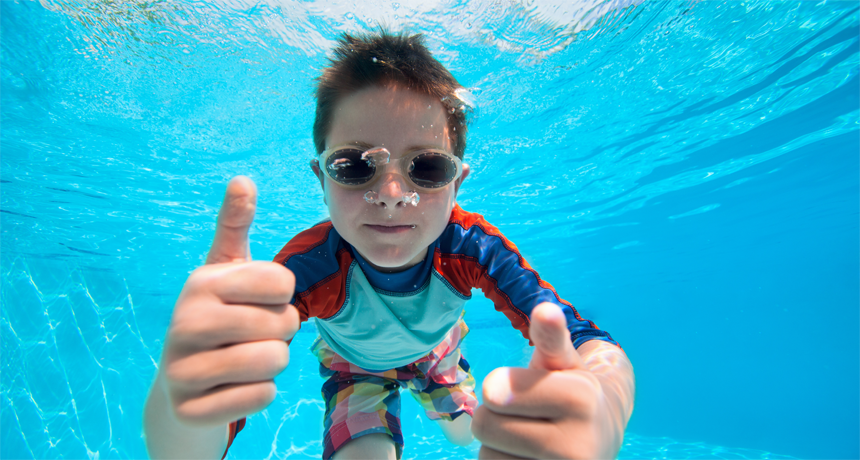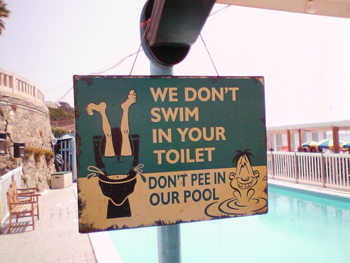Scientists know that you pee in the pool
Researchers can now measure the urine people leave in swimming pools and hot tubs

A new technique measures an artificial sweetener in pools to estimate how much pee swimmers have left behind.
shalamov/iStockphoto
By Sid Perkins
We know you would never do it. But some people pee in swimming pools and hot tubs. This isn’t just a gross habit. When chlorine reacts with urine, it creates chemicals that can irritate eyes and lungs. Now researchers can measure this disgusting behavior. They’ve found a simple way to estimate the volume of urine in a pool.
The technique could help people decide when to change some or all of the water in a pool or hot tub, the researchers say. But the new research isn’t really meant to create new rules for pool managers. It’s supposed to emphasize a message: Don’t pee in the pool!
By itself, urine in pools isn’t a problem. That’s because a healthy person’s pee is typically sterile, or germ-free, says Lindsay Blackstock. She’s an analytical chemist at the University of Alberta in Edmonton, Canada. But pool water also contains chlorine, a chemical that kills germs. Trouble can arise when that chlorine reacts with urine. It can trigger the production of dozens of new byproducts. Many of these new chemicals will cause no harm. But some, especially one called trichloramine (Try-KLOR-ah-meen), are known irritants.

Even if you’ve never heard of trichloramine, you’ve probably smelled it. That distinct “swimming pool smell” at most pools doesn’t come from the chlorine, notes Blackstock. It’s trichloramine. It can sting the eyes. The pungent chemical also can irritate the lungs.
As pee in a pool increases, the amounts of trichloramine will too. The more trichloramine there is, the more irritating it can be to swimmers. So Blackstock and her teammates wanted to see if they could estimate how much urine was present in pool water. There’s no simple way to test for urine directly. (Have you ever heard that pool water has a chemical in it that will change color if you pee? That’s only a myth.)
So the researchers needed a marker for the urine — some other substance that would signal the likely presence of pee. And that’s what caused them to focus on acesulfame (ASS-eh-sul-faym) potassium. It’s an artificial sweetener used in foods and drinks. It’s sold under the brand names Sunett and Sweet One. The chemical is also called Ace-K for short.
It makes a good marker for pee, says Blackstock. For one, it has no natural sources and is very stable. It doesn’t break down at normal temperatures, which is why many food manufacturers use Ace-K. Even after being stored in foods at room temperature for 10 years, it won’t have broken down. It also won’t break down in pools or be removed during water-cleanup treatments.
Moreover, Ace-K passes right through the human body without being digested. That makes it a great choice as a low-calorie sweetener (the body doesn’t get any energy from it). But it also made Ace-K a good choice for their study, says Blackstock. The substance doesn’t leave the body in sweat, breath or poop. Ace-K only leaves the body in urine. And when it comes out, it will be the same form of the chemical as had been ingested.
Foul findings
First, the researchers needed to know how much Ace-K is present in the average person’s urine. They collected urine samples from 20 people and mixed them together. Each milliliter of urine (about one-fifth of a teaspoon) contained about 2.36 micrograms of Ace-K.
Then, on 15 days in August 2016, the team collected water samples from two swimming pools in a city in Canada. One pool held about 420,000 liters (110,000 gallons). The other had about twice that volume. On the same days, the researchers also collected three samples from the city’s water supply.
One small pool had almost
8 gallons of urine; a larger one almost 20 gallons.
— Univ. of Alberta study
Liter-sized samples of the city’s tap water contained between 12 and 20 nanograms of Ace-K. (Remember, Ace-K doesn’t decompose during water treatment.) If there were no pee in the pools, they should have had similar levels of Ace-K. The smaller pool, though, had 156 nanograms of Ace-K per liter of water. And the larger pool had even more, about 210 nanograms per liter. That adds up to about 30 liters (almost 8 gallons) of urine in the small pool. The larger pool held a whopping 75 liters (almost 20 gallons) of pee!
These pools probably aren’t unusual, says Blackstock. In 2014, the same researchers found Ace-K in unusually high concentrations in 21 public swimming pools, 8 hot tubs and even a private swimming pool. In other words, every pool and hot tub they tested had pee in it. Blackstock and her team shared their new findings online March 1 in Environmental Science & Technology Letters.
The team’s approach “is a pretty cool idea,” says Beate Escher. She’s a toxicologist at the Helmholtz Center for Environmental Research in Leipzig, Germany. Researchers have used Ace-K before to measure water pollution, she says, both on and just beneath Earth’s surface. And Ace-K holds some advantages over other substances, such as caffeine, that researchers have used as a marker of urine. Caffeine, for instance, can break down after it leaves the body. “Ace-K is much more stable,” Escher says.
Like Blackstock and her team, Escher suggests the best way to tackle urine is pools is prevention, not clean-up. So please, she urges, don’t pee in the pool: “Self-control is the best thing.”







